 Lord Hayagriva is regarded as God of knowledge. He is one of the manifestations of Lord Vishnu. He is highly worshipped in South India., the term `Haya` means `horse` and `Griva` means `neck` in Sanskrit. This deity is depicted with a horse face and a man`s body. Hayagriva`s incarnation took place to restore the Vedas to Lord Brahma. According to `Devi Bhagarata`, a demon named Hayagriva received a boon that he would never be killed by man or an animal. He started troubling the gods. Devas went to Devi in order to get relief from the demon. They were advised to approach Lord Vishnu. They requested him to be born with the face of a horse and the body of a man to kill Hayagriva. Thereby Lord Vishnu took the incarnation of half-horse and half-man and killed the demon Hayagriva.
Lord Hayagriva is regarded as God of knowledge. He is one of the manifestations of Lord Vishnu. He is highly worshipped in South India., the term `Haya` means `horse` and `Griva` means `neck` in Sanskrit. This deity is depicted with a horse face and a man`s body. Hayagriva`s incarnation took place to restore the Vedas to Lord Brahma. According to `Devi Bhagarata`, a demon named Hayagriva received a boon that he would never be killed by man or an animal. He started troubling the gods. Devas went to Devi in order to get relief from the demon. They were advised to approach Lord Vishnu. They requested him to be born with the face of a horse and the body of a man to kill Hayagriva. Thereby Lord Vishnu took the incarnation of half-horse and half-man and killed the demon Hayagriva.
Hayagriva is primarily worshipped by the Vaishnavas. One of the most important temples of Hayagriva is situated in Tiruvendipuram in Tamil Nadu. He is portrayed very gently with two or four arms and often with eight or twelve arms also. The god is always shown carrying the conch and discus. When he is along with his spouse goddess Lakshmi he is also called Lakshmi Hayagriva. When he is in a yogic posture, he is also known as `Yoga Hayagriva`.
One can find some of the beautiful sculptures of Lord Hayagriva in The temple at Nuggehalli located in Karnataka. The inscription written at the bottom of the image says that this figure of Hayagriva was created by Malitamma. The sculpture here has eight hands which hold different weapons in each of them. The demon is represented in a very pathetic condition under the feet of this gracefully embellished deity.
He is generally portrayed as wearing white garments and seated on a white lotus. When one commences the study of sacred and secular subjects the blessings of lord Hayagriva is taken. On the day of full moon in the month of August he is worshipped. Marishi is believed to be his consort who is known to be the goddess of the rising sun. This is considered to be the female aspect of Lord Hayagriva. Hayagriva seated with his consort is depicted in Mysore`s Parakala Math.




















